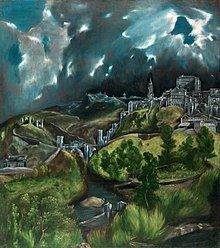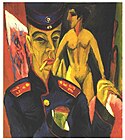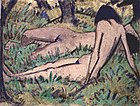Expressionism
Expressionism was a modernist movement, initially in poetry and painting, originating in Germany at the beginning of the 20th century. Its typical trait is to present the world solely from a subjective perspective, distorting it radically for emotional effect in order to evoke moods or ideas.[1][2] Expressionist artists sought to express meaning[3] or emotional experience rather than physical reality.[3][4]
Expressionism was developed as an avant-garde style before the First World War. It remained popular during the Weimar Republic,[1] particularly in Berlin. The style extended to a wide range of the arts, including painting, literature, theatre, dance, film, architecture and music.
The term is sometimes suggestive of emotional angst. In a general sense, painters such as Matthias Grünewald and El Greco are sometimes termed expressionist, though in practice the term is applied mainly to 20th-century works. The Expressionist emphasis on individual perspective has been characterized as a reaction to positivism and other artistic styles such as naturalism and impressionism.[5]
Contents |
[edit] Origin of the term
|
|
This section needs additional citations for verification. Please help improve this article by adding reliable references. Unsourced material may be challenged and removed. (March 2009) |
The term was invented by Czech art historian Antonín Matějček in 1910 as the opposite of impressionism: "An Expressionist wishes, above all, to express himself... (an Expressionist rejects) immediate perception and builds on more complex psychic structures... Impressions and mental images that pass through mental peoples soul as through a filter which rids them of all substantial accretions to produce their clear essence [...and] are assimilated and condense into more general forms, into types, which he transcribes through simple short-hand formulae and symbols." (Gordon, 1987)

The term "Expressionism" is usually associated with paintings, graphic work, and other forms of artistic practice in Germany at the beginning of the 20th century that challenged academic traditions, particularly the Die Brücke and Der Blaue Reiter groups.
Philosopher Friedrich Nietzsche had a role in originating modern Expressionism. In the publication The Birth of Tragedy, Nietzsche presented his theory of the ancient dualism between two types of aesthetic experience—the Apollonian and the Dionysian; a dualism between the plastic "art of sculpture", of lyrical dream-inspiration, identity (the principium individuationis), order, regularity, and calm repose; and, on the other hand, the non-plastic "art of music", of intoxication, forgetfulness, chaos, and the ecstatic dissolution of identity in the collective. Nietzsche argues that classical tragedy is formed generally by both principles (later, he argues, it degenerates as Socratic reason replaces the Apollonian principle). The basic characteristics of Expressionism are Dionysian: bold colours, distorted forms-in-dissolution, two-dimensional, without perspective.[6]
More generally, the term refers to art that expresses intense emotion. It is arguable that all artists are expressive but there are many examples of art production in Europe from the 15th century onward which emphasize emotion. Such art often occurs during times of social upheaval, such as the Protestant Reformation, German Peasants' War, Eight Years' War, and Spanish Occupation of the Netherlands, when the rape, pillage and disaster associated with periods of chaos and oppression are presented in the documents of the printmaker. Often the work is unimpressive aesthetically,[citation needed] but almost without exception has the capacity to cause the viewer to experience strong emotions with the drama and often horror of the scenes depicted.
Expressionism has been likened to Baroque by critics such as art historian Michel Ragon[7] and German philosopher Walter Benjamin.[8] A difference between the two is that "Expressionism doesn't shun from the violently unpleasant effect, while baroque does. Expressionism throws some terrific "Fuck you"s, baroque doesn't. Baroque is well-mannered."[9]
[edit] Visual artists



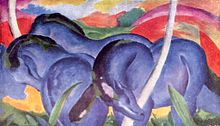
Some of the style's main visual artists of the early 20th century were:
- Australia: Sidney Nolan, Charles Blackman, John Perceval, Albert Tucker and Joy Hester
- Austria: Egon Schiele, Oskar Kokoschka and Alfred Kubin
- Belgium: Constant Permeke, Gustave De Smet, Frits Van den Berghe, James Ensor, Albert Servaes, Floris Jespers and Albert Droesbeke.
- Brazil: Anita Malfatti, Cândido Portinari, Di Cavalcanti and Lasar Segall.
- Finland: Tyko Sallinen,[10] Alvar Cawén, Juho Mäkelä and Wäinö Aaltonen.
- France: Georges Rouault, Georges Gimel, Gen Paul and Chaim Soutine
- Germany: Ernst Barlach, Max Beckmann, Fritz Bleyl, Heinrich Campendonk, Otto Dix, Conrad Felixmüller, George Grosz, Erich Heckel, Carl Hofer, Ernst Ludwig Kirchner, Paul Klee, Käthe Kollwitz, Wilhelm Lehmbruck, Elfriede Lohse-Wächtler, August Macke, Franz Marc, Ludwig Meidner, Paula Modersohn-Becker, Otto Mueller, Gabriele Münter, Rolf Nesch, Emil Nolde, Max Pechstein and Karl Schmidt-Rottluff.
- Hungary: Tivadar Kosztka Csontváry
- Iceland: Einar Hákonarson
- Ireland: Jack B. Yeats
- Indonesia: Affandi
- Italy: Emilio Giuseppe Dossena
- Mexico: Mathias Goeritz (German émigré to Mexico), Rufino Tamayo
- Netherlands: Charles Eyck, Willem Hofhuizen, Jaap Min, Jan Sluyters, Vincent van Gogh, Jan Wiegers and Hendrik Werkman
- Norway: Edvard Munch, Kai Fjell
- Poland: Henryk Gotlib
- Portugal: Mário Eloy, Amadeo de Souza Cardoso
- Russia: Wassily Kandinsky, Marc Chagall, Alexej von Jawlensky, Natalia Goncharova, Konrad Magi, Eduard Wiiralt, Mstislav Dobuzhinsky, and Marianne von Werefkin (Russian-born, later active in Switzerland).
- Switzerland: Carl Eugen Keel, Cuno Amiet
- USA: Ivan Albright, Milton Avery, George Biddle, Hyman Bloom, Peter Blume, Charles Burchfield, David Burliuk, Stuart Davis, Elaine de Kooning, Willem de Kooning, Beauford Delaney, Arthur G. Dove, Norris Embry, Philip Evergood, Kahlil Gibran, William Gropper, Philip Guston, Marsden Hartley, Albert Kotin, Yasuo Kuniyoshi, Rico Lebrun, Jack Levine, Alfred Henry Maurer, Alice Neel, Abraham Rattner, Ben Shahn, Harry Shoulberg, Joseph Stella, Harry Sternberg, Henry Ossawa Tanner, Dorothea Tanning, Max Weber, Hale Woodruff and Karl Zerbe
[edit] Expressionist groups of painters
The style originated principally in Germany and Austria. There were a number of groups of Expressionist painters, including Der Blaue Reiter and Die Brücke. Der Blaue Reiter (The Blue Rider, named for a magazine) was based in Munich and Die Brücke was based originally in Dresden (although some members later relocated to Berlin). Die Brücke was active for a longer period than Der Blaue Reiter, which was only together for a year (1912). The Expressionists had many influences, among them Edvard Munch, Vincent van Gogh, and African art.[11] They were also aware of the work being done by the Fauves in Paris, who influenced Expressionism's tendency toward arbitrary colours and jarring compositions. In reaction and opposition to French Impressionism, which emphasized the rendering of the visual appearance of objects, Expressionist artists sought to portray emotions and subjective interpretations. It was not important to reproduce an aesthetically pleasing impression of the artistic subject matter, they felt, but rather to represent vivid emotional reactions by powerful colours and dynamic compositions. Kandinsky, the main artist of Der Blaue Reiter group, believed that with simple colours and shapes the spectator could perceive the moods and feelings in the paintings, a theory that encouraged him towards increased abstraction.
The ideas of German expressionism influenced the work of American artist Marsden Hartley, who met Kandinsky in Germany in 1913.[12] In late 1939, at the beginning of World War II, New York received a great number of major European artists. After the war, Expressionism influenced many young American artists. Norris Embry (1921–1981) studied with Oskar Kokoschka in 1947 and during the next 43 years produced a large body of work with the Expressionist tradition. Norris Embry has been termed "the first American German Expressionist". Other American artists of the late 20th and early 21st century have developed distinct styles that may be considered part of Expressionism. Another prominent artist who came from the German Expressionist "school" was Bremen-born Wolfgang Degenhardt. After working as a commercial artist in Bremen, he migrated to Australia in 1954 and became quite well known in the Hunter Valley region.
American Expressionism[13] and American Figurative Expressionism, particularly the Boston figurative expressionism,[14] were an integral part of American modernism around the Second World War.

Major figurative Boston Expressionists included: Karl Zerbe, Hyman Bloom, Jack Levine, David Aronson, Philip Guston. The Boston figurative Expressionists post World War II were increasingly marginalized by the development of abstract expressionism centered in New York City.
After World War II, figurative expressionism influenced worldwide a large number of artists and styles. Thomas B. Hess wrote that "the ‘New figurative painting’ which some have been expecting as a reaction against Abstract Expressionism was implicit in it at the start, and is one of its most lineal continuities."[15]
- New York Figurative Expressionism[16][17] of the 1950s represented New York figurative artists such as Robert Beauchamp, Elaine de Kooning, Robert Goodnough, Grace Hartigan, Lester Johnson, Alex Katz, George McNeil, Jan Muller, Fairfield Porter, Gregorio Prestopino, Larry Rivers and Bob Thompson.
- Lyrical Abstraction, Tachisme[18] of the 1940s and 1950s in Europe represented by artists such as Georges Mathieu, Hans Hartung, Nicolas de Staël and others.
- Bay Area Figurative Movement[19][20] represented by early figurative expressionists from the San Francisco area Elmer Bischoff Richard Diebenkorn, and David Park. The movement from 1950 to 1965 was joined by Theophilus Brown, Paul Wonner, James Weeks, Hassel Smith, Nathan Oliveira, Bruce McGaw, Joan Brown, Manuel Neri, Joan Savo and Roland Peterson.
- Abstract Expressionism of the 1950s represented American artists such as Louise Bourgeois, Hans Burkhardt, Mary Callery, Nicolas Carone, Willem de Kooning, Jackson Pollock, and others [21][22] that participated with figurative expressionism.
- In the United States and Canada, Lyrical Abstraction beginning during the late 1960s and the 1970s. Characterized by the work of Dan Christensen, Peter Young, Ronnie Landfield, Ronald Davis, Larry Poons, Walter Darby Bannard, Charles Arnoldi, Pat Lipsky and many others.[23][24][25]
- Neo-expressionism was an international revival style that began in the late 1970s and included artists from many nations:
- Germany: Anselm Kiefer and Georg Baselitz and others;
- USA: Jean-Michel Basquiat, Eric Fischl, David Salle and Julian Schnabel;
- Cuba: Pablo Carreno;
- France: Rémi Blanchard, Hervé Di Rosa and others;
- Italy: Francesco Clemente, Sandro Chia and Enzo Cucchi;
- England: David Hockney, Frank Auerbach and Leon Kossoff
- Belarus: Natalia Chernogolova
[edit] Selected Expressionist paintings
-
August Macke, Lady in a Green Jacket, 1913
-
Franz Marc, Fighting Forms, 1914.
-
Egon Schiele, Pair of Women (Women embracing each other), 1915.
-
Amedeo Modigliani, Diego Rivera, 1914.
-
Ernst Ludwig Kirchner, Nollendorfplatz, 1912
-
Ernst Ludwig Kirchner, Self-Portrait as a Soldier, 1915
-
Otto Mueller, Two Girls in the Wood, 1920-25,
[edit] In other arts
|
|
This section does not cite any references or sources. Please help improve this section by adding citations to reliable sources. Unsourced material may be challenged and removed. (December 2009) |
The Expressionist movement included other types of culture, including dance, sculpture, cinema and theatre.
[edit] Dance
Exponents of expressionist dance included Mary Wigman, Rudolf von Laban, and Pina Bausch.
[edit] Sculpture
Some sculptors used the Expressionist style, as for example Ernst Barlach. Other expressionist artists known mainly as painters, such as Erich Heckel, also worked with sculpture.
[edit] Cinema
There was an Expressionist style in the cinema, important examples of which are Robert Wiene's The Cabinet of Dr. Caligari (1920), The Golem: How He Came Into the World (1920), Fritz Lang's Metropolis (1927) and F. W. Murnau's Nosferatu, a Symphony of Horror (1922) and The Last Laugh (1924). The term "expressionist" is also sometimes used to refer to stylistic devices thought to resemble those of German Expressionism, such as Film Noir cinematography or the style of several of the films of Ingmar Bergman. More generally, the term expressionism can be used to describe cinematic styles of great artifice, such as the technicolor melodramas of Douglas Sirk or the sound and visual design of David Lynch's films.
[edit] Literature
In literature, the novels of Franz Kafka are often described as Expressionist. Expressionist poetry also flourished, mainly in the German-speaking countries. The most influential Expressionist poets were Georg Trakl, Georg Heym, Ernst Stadler, Gottfried Benn and August Stramm.
[edit] Theatre
There was a concentrated Expressionist style in early 20th-century German theatre, of which Georg Kaiser and Ernst Toller were the most famous playwrights. Other notable Expressionist dramatists included Reinhard Sorge, Walter Hasenclever, Hans Henny Jahnn, and Arnolt Bronnen. They considered Swedish playwright August Strindberg and German actor and dramatist Frank Wedekind as precursors of their dramaturgical experiments. During the 1920s, Expressionism enjoyed a brief period of popularity in American theatre, including plays by Eugene O'Neill (The Hairy Ape, The Emperor Jones and The Great God Brown), Sophie Treadwell (Machinal) and Elmer Rice (The Adding Machine).
Oskar Kokoschka's 1909 playlet, Murderer, The Hope of Women is often termed the first expressionist drama. In it, an unnamed man and woman struggle for dominance. The man brands the woman; she stabs and imprisons him. He frees himself and she falls dead at his touch. As the play ends, he slaughters all around him (in the words of the text) "like mosquitoes." The extreme simplification of characters to mythic types, choral effects, declamatory dialogue and heightened intensity all would become characteristic of later expressionist plays. The young Paul Hindemith created an operatic version of this play, which premiered in 1921.
Expressionist plays often dramatise the spiritual awakening and sufferings of their protagonists. Some utilise an episodic dramatic structure and are known as Stationendramen (station plays), modeled on the presentation of the suffering and death of Jesus in the Stations of the Cross. August Strindberg had pioneered this form with his autobiographical trilogy To Damascus.
The plays often dramatise the struggle against bourgeois values and established authority, often personified by the Father. In Sorge's The Beggar, (Der Bettler), the young hero's mentally ill father raves about the prospect of mining the riches of Mars and is finally poisoned by his son. In Bronnen's Parricide (Vatermord), the son stabs his tyrannical father to death, only to have to fend off the frenzied sexual overtures of his mother.
In Expressionist drama, the speech is either expansive and rhapsodic, or clipped and telegraphic. Director Leopold Jessner became famous for his expressionistic productions, often set on stark, steeply raked flights of stairs (having borrowed the idea from the Symbolist director and designer, Edward Gordon Craig.
[edit] Music
Arnold Schoenberg, Anton Webern and Alban Berg, the members of the Second Viennese School, wrote pieces described as Expressionist (Schoenberg also made Expressionist paintings). Later composers, such as Ernst Krenek, are often considered as a part of the Expressionist style of music. What distinguished these composers from their contemporaries (such as Maurice Ravel, George Gershwin and Igor Stravinsky) is that Expressionist composers used atonality self-consciously to free their work from traditional tonality. They also sought to express the subconscious, the 'inner necessity' and suffering through their dissonant musical language. Erwartung and Die Glückliche Hand, by Schoenberg, and Wozzeck, an opera by Alban Berg (based on the play Woyzeck by Georg Büchner), are examples of Expressionist works.
[edit] Architecture

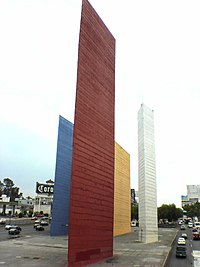
In architecture, two specific buildings are identified as Expressionist: Bruno Taut's Glass Pavilion of the Cologne Werkbund Exhibition (1914), and Erich Mendelsohn's Einstein Tower in Potsdam, Germany completed in 1921. The interior of Hans Poelzig's Berlin theatre (the Grosse Schauspielhaus), designed for the director Max Reinhardt, is also cited sometimes. The influential architectural critic and historian Sigfried Giedion, in his book Space, Time and Architecture (1941), dismissed Expressionist architecture as a part of the development of functionalism. In Mexico, in 1953, German émigré Mathias Goeritz, published the "Arquitectura Emocional" (Architecture emotional) manifesto with which he declared that "architecture's principal function is emotion".[26] Modern Mexican architect Luis Barragán adopted the term that influenced his work. The two of them collaborated in the project Torres de Satélite (1957–58) guided by Goeritz's principles of Arquitectura Emocional. It was only during the 1970s that Expressionism in architecture came to be re-evaluated more positively.
[edit] References
- ^ a b Bruce Thompson, University of California, Santa Cruz, lecture on WEIMAR CULTURE/KAFKA'S PRAGUE
- ^ Chris Baldick Concise Oxford Dictionary of Literary Terms, entry for Expressionism
- ^ a b Victorino Tejera, 1966, pages 85,140, Art and Human Intelligence, Vision Press Limited, London
- ^ The Oxford Illustrated Dictionary, 1976 edition, page 294
- ^ Garzanti, Aldo (1974) [1972] (in Italian). Enciclopedia Garzanti della letteratura. Milan: Guido Villa. pp. 963. page 241
- ^ See Nietzsche (1872, sections 1-6).
- ^ Michel Ragon (1968) Expressionism quotation:
There is no doubt that Expressionism is Baroque in essence
- ^ Benjamin, Walter (1998). Origin of German Tragic Drama. London: Verso. ISBN 978-1859848999.
- ^ Gabriele Pedullà, Alberto Arbasino [2000] Sull'albero di ciliegie [On the cherry tree] - Conversando di letteratura e di cinema con Alberto Arbasino in CONTEMPORANEA Rivista di studi sulla letteratura e sulla comunicazione, Volume 1, 2003 quotation:
translation:L’espressionismo non rifugge dall’effetto violentemente sgradevole, mentre invece il barocco lo fa. L’espressionismo tira dei tremendi «vaffanculo», il barocco no. Il barocco è beneducato
Expressionism doesn't shun from the violently unpleasant effect, while baroque does. Expressionism throws some terrific "Fuck you"s, baroque doesn't. Baroque is well-mannered.
- ^ Ian Chilvers, The Oxford dictionary of art, Volume 2004, Oxford University Press, p. 506. ISBN 0198604769
- ^ Ian Buruma, "Desire in Berlin", New York Review of Books, December 8, 2008, p. 19.
- ^ "Hartley, Marsden", Oxford Art Online
- ^ Bram Dijkstra, American expressionism : art and social change, 1920-1950,(New York : H.N. Abrams, in association with the Columbus Museum of Art, 2003.) ISBN 0810942313 9780810942318
- ^ Judith Bookbinder, Boston modern: figurative expressionism as alternative modernism (Durham, N.H. : University of New Hampshire Press ; Hanover : University Press of New England, ©2005.) ISBN 1584654880 9781584654889
- ^ Thomas B. Hess, “The Many Deaths of American Art,” Art News 59 (October 1960), p.25
- ^ Paul Schimmel and Judith E Stein, The Figurative fifties : New York figurative expressionism (Newport Beach, California : Newport Harbor Art Museum : New York : Rizzoli, 1988.) ISBN 0847809420 9780847809424 0917493125 9780917493126
- ^ “Editorial,” Reality, A Journal of Artists’ Opinions (Spring 1954), p. 2.
- ^ Flight lyric, Paris 1945-1956, texts Patrick-Gilles Persin, Michel and Pierre Descargues Ragon, Musée du Luxembourg, Paris and Skira, Milan, 2006, 280 p. ISBN 8876246797.
- ^ Caroline A. Jones, Bay Area figurative art, 1950-1965, (San Francisco, California : San Francisco Museum of Modern Art ; Berkeley : University of California Press, ©1990.) ISBN 9780520068421
- ^ American Abstract and Figurative Expressionism: Style Is Timely Art Is Timeless (New York School Press, 2009.) ISBN 9780967799421 pp. 44-47; 56-59; 80-83; 112-115; 192-195; 212-215; 240-243; 248-251
- ^ Marika Herskovic, American Abstract Expressionism of the 1950s An Illustrated Survey, (New York School Press, 2000. ISBN 0-9677994-1-4. pp. 46-49; pp. 62-65; pp. 70-73; pp. 74-77; pp. 94-97; 262-264
- ^ American Abstract and Figurative Expressionism: Style Is Timely Art Is Timeless: An Illustrated Survey With Artists' Statements, Artwork and Biographies(New York School Press, 2009. ISBN 9780967799421. pp.24-27; pp.28-31; pp.32-35; pp. 60-63; pp.64-67; pp.72-75; pp.76-79; pp. 112-115; 128-131; 136-139; 140-143; 144-147; 148-151; 156-159; 160-163;
- ^ Ryan, David (2002). Talking painting: dialogues with twelve contemporary abstract painters, p.211, Routledge. ISBN 0415276292, ISBN 9780415276290. Available on Google Books.
- ^ "Exhibition archive: Expanding Boundaries: Lyrical Abstraction", Boca Raton Museum of Art, 2009. Retrieved 25 September 2009.
- ^ "John Seery", National Gallery of Australia. Retrieved 25 September 2009.
- ^ Mathias Goeritz, "El manifiesto de arquitectura emocional", in Lily Kassner, Mathias Goeritz, UNAM, 2007, p. 272-273
[edit] Further reading
- Antonín Matějček cited in Gordon, Donald E. (1987). Expressionism: Art and Ideas, p. 175. New Haven: Yale University Press.
- Jonah F. Mitchell (Berlin, 2003). Doctoral thesis Expressionism between Western modernism and Teutonic Sonderweg. Courtesy of the author.
- Friedrich Nietzsche (1872). The Birth of Tragedy Out of The Spirit of Music. Trans. Clifton P. Fadiman. New York: Dover, 1995. ISBN 0486285154.
- Judith Bookbinder, Boston modern: figurative expressionism as alternative modernism, (Durham, N.H. : University of New Hampshire Press; Hanover: University Press of New England, ©2005.) ISBN 1584654880 9781584654889
- Bram Dijkstra, American expressionism: art and social change, 1920-1950, (New York : H.N. Abrams, in association with the Columbus Museum of Art, 2003.) ISBN 0810942313 9780810942318
- Ditmar Elger Expressionism-A Revolution in German Art ISBN 978-3-8228-3194-6
- Paul Schimmel and Judith E Stein, The Figurative fifties : New York figurative expressionism, The Other Tradition (Newport Beach, California : Newport Harbor Art Museum : New York : Rizzoli, 1988.) ISBN 0847809420 9780847809424 0917493125 9780917493126
- Marika Herskovic, American Abstract and Figurative Expressionism: Style Is Timely Art Is Timeless (New York School Press, 2009.) ISBN 9780967799421.
[edit] External links
| Wikimedia Commons has media related to: Expressionist paintings |
| Look up expressionism in Wiktionary, the free dictionary. |
- Hottentots in tails A turbulent history of the group by Christian Saehrendt at signandsight.com
- Expressionism
- The Official Website of the Norris Embry Estate A free educational resource on Expressionism, including a large collection of expressionist paintings by the American artist Norris Embry (1921–1981).
- German Expressionism A free resource with paintings from German expressionists (high-quality).
|
|||||||||||||||||||||||
|
||||||||||||||||||||
|
||||||||

